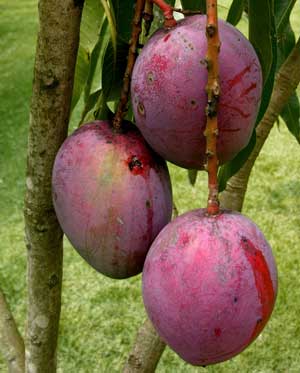Sherry from Valdosta, GA
If you want to grow it as a houseplant, yes. If you're interested in home fruit production, probably not. Mangoes are adapted to tropical and subtropical areas, meaning consistent summer-like temperatures are a major factor in determining their success. This fruit tree is extremely sensitive to cold. At temperatures below 40ºF, a mango tree's ability to flower and produce fruit becomes seriously compromised.
If you want to grow an exotic house plant, mango trees are an excellent choice. They develop large, beautiful leathery leaves. You can start your own by extracting the hairy husk from within the flesh of a mango you buy at the grocery store. This husk contains the seed. Clean the husk by removing any remaining fruit and cure it (leave it out to dry) overnight. After the husk is dry, gently pry it open with a knife and carefully remove the seed and place it into a plastic bag filled with damp moss or moist paper towels. Keep it in a warm place, preferably with temperatures as close to 80ºF as possible.
Good luck!
Ellen
I would like to grow a mango tree in my yard. If an apple tree can survive the cold, why not my mango tree? How hard would it be? Any suggestions would be helpful.
Hardiness Zone: 6a
Susie from Celina, Ohio
Susie,
To flower and set fruit, mangoes need a frost-free climate. There are no cold-resistant varieties. Any temperatures below 40ºF, even if only for a short time, are likely to kill the flowers and the fruit. Young trees can be seriously damaged at temperatures below 30° F and most mature trees will only take temperatures in the twenties for a short period of time.
That said, if you have a sunny room indoors you may consider growing a mango tree as a houseplant. To start one from a fruit, remove the hairy husk from inside the fruit (the seed is inside the husk), clean off any pulp and let it dry 24 hours. After it dries overnight, use a dull knife to pry open the husk and remove the seed. Place the seed in a plastic bag filled with damp moss or newspaper and keep in in a warm place until it germinates (2-3 weeks). You can transplant the sprouted seed into a pot filled with well-drained, nutrient-rich soil. Keep the soil damp (not wet). Your seed will eventually grow into an attractive houseplant, but it is extremely unlikely it will ever flower or bear fruit indoors.
Ellen

Apple trees are grown in cooler climates. Alas, mango trees are tropical and one can't even grow one well in San Diego! I live in No. Cal and can't grow one that will fruit here. (03/17/2006)
By
Another option would be to grow one as a houseplant. Have a look at http://www.plantea.com/mango-houseplant.htm (03/17/2006)
By Erin
You should be able to successfully grow mango trees provided you don't get regular or heavy frost in winter. Mangoes hate frost, and will die easily if frosted often or hard. If you wish to plant a mango, it's really easy, just dry the seed out once you've eaten it and plant it with the hairiest end up, (point down) in plain soil, preferably slightly sandy soil. Good luck! (08/24/2006)
By Stephanie
You don't have to go through all the trouble of opening the seed pod. All you do is lay the clean hairy mango seed flat on top of a pot of soil and gently press into soil but don't completely cover it. This is the way they do it in Bolivia. I have two mango trees growing on my patio zone 9 in half day shade. They are a foot tall now. My friend from Bolivia said if you want fruit then you have to have two trees for pollination. (10/02/2006)
By anita banita
Add your voice! Click below to comment. ThriftyFun is powered by your wisdom!
I have an 8+ foot tall glen mango tree. I am planting in the yard because the pot is too small. How should I cover roots and leaves to prevent frost bite in winter. Will it produce mangoes if I do this?
Add your voice! Click below to comment. ThriftyFun is powered by your wisdom!